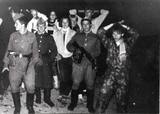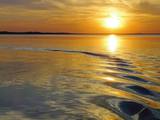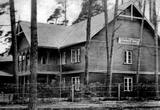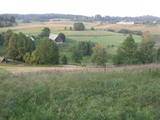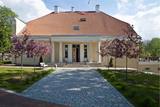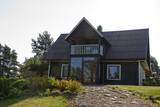| Nr | Nosaukums | Apraksts |
|---|---|---|
|
Padomju robežsardze Lapmežciemā (uz Lapmežciema un Ragaciema robežas) ieradās sešdesmito gadu vidū, bet pameta 1991. gadā. Šajā objektā strādāja ap 50 militārās personas. Ragaciemieši un militāristi rīkoja kopējus pasākumus, piedalījās dažādās svinībās. Vietējos iedzīvotājus satrauca tikai radars, ar kura klātbūtni saistīja dažādas ikdienas nebūšanas. 1991. gadā zenītraķetes demontēja un aizveda nezināmā virzienā. Līdz šodienai bijušajā armijas teritorijā saglabājusies daudzdzīvokļu dzīvojamā māja. |
||
|
Atrodas pie Kuldīgas pils dzirnavām, kur straujā Alekšupīte pirms ietekas Ventā izgrauzusi dziļu „kanjonu” dolomītā. Šo dēvē par vienu no augstākajiem Latvijas ūdenskritumiem (4,15 m). 17. gs. ūdenskritumu ievērojami pārveidoja – paaugstināja un nostiprināja, lai Alekšupītes straumi izmantotu dzirnavu darbināšanai. Upītes kreisais krasts ir labiekārtots. |
||
|
Tulkojumā no Igauņu valodas Luitemaa nozīmē „Kāpu zeme”. Piekrastes teritorija 13 km garumā starp Vöiste un Häädemeeste ar seklūdeņiem, plašām piejūras pļavām, Igaunijas augstāko kāpu masīvu un Tolkuses purvu (Tolkuse raba). Nozīmīga putnu vieta.
|
||
|
Rāznas ezers (57,8 km2), saukts par Latgales jūru, pēc ūdens
ietilpības lielākais Latvijā, atrodas Latgales augstienes Rāznavas paugurainē.
Tā gleznainajā apkārtnē paceļas Latgales augstākās virsotnes un
latgaļu pilskalni. Ezera krastos atrodas iecienītas atpūtas vietas. Lai
pasargātu un saglabātu unikālo dabas kompleksu, izveidots Rāznas
Nacionālais parks un teritorija iekļauta Eiropas Savienības aizsargājamo
teritoriju tīklā Natura 2000. Ezerā ir 10 salas, divi līči. Ezera ūdens līmenis
ir 163,8 m virs jūras līmeņa.
|
||
|
Daiļamata meistars no koka taisa karotes (no liepas, bērza koka) un pirtsslotas (ar āboliem). Darba vērošana, iespēja pašiem izgatavot karoti, gatavās produkcijas iegāde un karošu kolekcijas apskate. Aplūkot vērtas ir vecās saimniecības ēkas. |
||
|
„Strand” komplekss bija lielākais un greznākais Neibādē. Tas sastāvēja no trim ēkām, deju paviljona un parka. Mūsdienās saglabājusies tikai viesnīcas ēka, kurā bija iekārtota Saulkrastu ambulance – Ainažu ielā Nr. 17. (Avots: Saulkrastu TIC) |
||
|
Dabas liegums veidots Alūksnes augstienes augstākā lielpaugura – Dēliņkalna un tā nogāzēs esošo biotopu (nogāžu meži u.c.), kā arī apkārtējās ainavas aizsardzībai. Paugura nogāzēs izveidota kalnu slēpošanas trases un no tā dienviddaļas paveras izcila ainava. Dabas liegums atrodas Veclaicenes aizsargājamo ainavu apvidū (sk. sadaļu "Aizsargājamo ainavu apvidi").
|
||
|
Neliels meža masīvs austrumos no Cirstes – Mazirbes ceļa
krustojumā ar Kolkas – Ventspils ceļu. Teiku vieta. Cauri Kaziņmežam pa Krustceļu
nonākam pie Kolkas – Ventspils ceļa (P 124) krustojuma
|
||
|
The tour combines the most beautiful southern parts of the Forest Trail in Lithuania and Latvia. The route starts in Druskininkai, Lithuania, and for the next day you will walk through forests of the Dzūkija National Park. After getting to Vilnius and Kurtuvėnai Regional Park, two sections of the Forest Trail will take you from Dengtiltis to Šaukėnai. Since it is among the most forested areas of Central Lithuania, the Kurtuvėnai Regional Park with its glaciated valleys is a wonderland of forests, waters and wetlands. The Forest Trail will run along small forest paths, tourist trails, beautiful tree alleys and wetlands. Next you will take public transportation to reach the Žemaitija National Park, where you will taketwo sections of the Forest Trail from the pilgrimage town of Žemaičių Kalvarija along the lakes of Plateliai, Ilgis and Beržoras to the town of Plateliai. It is one of the most beautiful towns of Samogitia taking pride in its manor park and the viewing platform on Lake Plateliai. Žemaitija National Park takes pride in its old pine and fir forests, as well as mixed forests. From there on the Forest Trail takes you along the riverside promenade in Kuldīga, continues through the nature park “Abavas senleja” from Renda to the wine and cider town Sabile and Kandava. The section along the Abava River Valley Nature Park is the most diverse river valley in Kurzeme in terms of landscapes and terrain. The final section of the tour takes you to the Ķemeri National Park, which is an important place for the protection of wetlands. As to the town – Ķemeri – it is the former balneological and sulphur springs resort. The tour ends on the seaside – the village of Bigauņciems, from where you can easily get to Rīga. Optionally, one can take a detour along the Lake Sloka trail with its bird-watching tower or pay a visit to the “Forest House” – the visitor’s centre of the Ķemeri National Park. |
||
|
Keues muiža pirmo reizi tika sākta būvēt ap 1241. gadu. Muiža tika resaurēta, iedvesmojoties no ēkas interesantās pagātnes un izmantotā izdoma liek tai izcelties starp visām pārējām muižām. Keues muiža ir apbalvota ar balvu "2016 World Boutique Hotel Award" kategorijā ''World’s Most Inspired Design Hotel.'' |
||
|
Kafejnīca "Dižjūra" atrodas Mazirbē, Lībiešu tautas namā. Atvērta vasaras sezonā. |
||
|
Dodieties ekskursijā, lai gūtu ieskatu lauku profesijā un dzīvesveidā, kā arī iegūtu jaunus iespaidus un labu atpūtu visai klasei. Ekskursijas laikā apmeklējiet Salmu muzeju, kur apskatāmas gandrīz 500 salmu skulptūras un lelles, kā arī iespēja darboties radošajā darbnīcā un iegūt pamata prasmes darbā ar salmiem un sienu. Pēc tam apmeklējiet zvejnieku sētu, kas piedāvā aktīvu atpūtu pie jūras ar visādām izdarībām jūras krastā, zvejnieksievu stāstus par vēsturi un sadzīves "teijātri" vietējā dialektā, ieskatu zivju kūpināšanas procesā un, protams, mielastu ar riktīgu vietējo zivju izgaršošanu. Ekskursijas noslēgumā dodieties uz mini zoo, lai iepazītos ar eksotiskajiem dzīvniekiem un mājdzīvniekiem, kurus iespējams pabarot, kā arī samīļot. |
||
|
Ciemos gaidīti gan pāri, gan ģimenes, gan draugu kompānijas. Lauku sēta sastāv no piecām ēkām. Neskartā daba un tīrais gaiss ļaus atpūsties pilnīgā klusumā. Ap 50 m no Šventosios (Svētās) upes atrodas galvenā ēka, kurā ir divas guļamistabas ar tualeti un dušu nakšņošanai līdz 10 personām. Pirts namiņš būs ērts draugu lokam līdz 9 cilvēkiem. Pieejami trīs jauni VIP namiņi 2-4 cilvēkiem upes krastā. Piemērota vieta kāzu, dzimšanas dienu u.c. svinībām. |
||
|
Uzņēmumam ir vairāk kā 40 gadus ilga darbības vēsture. Mūsdienas tas kļuvis par Baltijas mēroga konkurētspējīgu piena pārstrādes uzņēmumu, kur ražo pienu, kefīru, biezpienu, jogurtu, sviestu, sierus u.c. piena pārstrādes produktus. Produkciju var iegādāties uzņēmumam blakus esošajā veikalā. Viens no pieciem Latvijas uzņēmumiem, kas drīkst ražot ES garantēto tradicionālo īpatnību produktu - „Jāņu sieru”. |
||
|
No teikām un nostāstiem apvītā stāvā paugura (ap 66 m virs tuvākās apkārtnes) dienvidu nogāzes skatu stigas paveras skats uz Burtnieku līdzenumu. Tornis nav publiski pieejams.
|
||
|
Kafejnīca “Kursas zeme” atrodas vecpilsētas centrā – rātslaukumā. Tajā ir divas zāles, kā arī vasaras terase rātslaukuma pusē. Interjers pielāgots senās pilsētas aurai - ar vintage stila lampām un gleznām pie sienām. Kafejnīcas telpās atrodas arī kafijas grauzdētava “Curonia”, tāpēc apmeklētājiem tiek piedāvāta svaiga un garšīga kafija. |
||
|
Atrodas Ganību ielā 120. Celta (iesvētīta 2001. g.) mūsdienu modernās arhitektūras formās un interesanta ar faktu, ka sākotnēji bijusi Vatikāna paviljons Pasaules izstādē “Expo 2000” Hannoverē. To pārbūvēja un uz Liepāju pārcēla par Vācijas katoļu saziedotajiem līdzekļiem. Ēkā darbojas katoļu draudzes centrs. |
||
|
Vieni no retajiem Latvijas tāšu pinējiem piedāvā iepazīt darbnīcu, apskatīt no tāsīm darinātus priekšmetus un dalīties pieredzē. Ikviens interesents ar meistaru palīdzību no bērzu tāss var izgatavot vienkāršus priekšmetus, kas noderēs kā lieliski suvenīri. |
||
|
19. gs. otrajā pusē celtajā ēkā atrodas Limbažu muzeja krājums un tūrisma informācijas centrs. No torņa (stiklotas grīdas) paveras skats un vecpilsētu. |
||
|
Restorāns atrodas viesu mājā "Liedags" Liepājas - Venstpils šosejas malā 4.5 km no Jūrkalnes Ēnavītes upītes krastā. |
||
